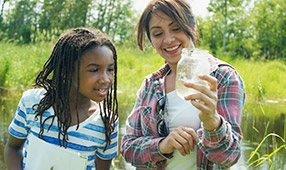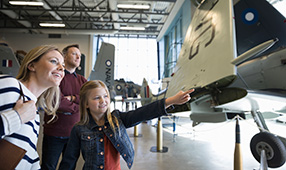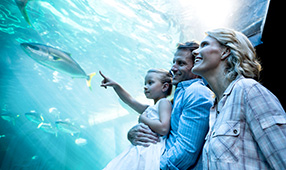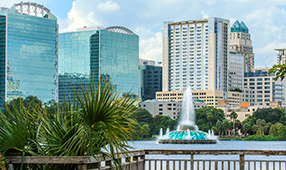Research shows that many students who have the chance to take educational field trips say they had a positive impact on them for years to come. Part of the reason is because such trips were engaging, stimulating and thought-provoking.
Although virtual field trips may not be able to completely replace in-person field trips, they certainly can be engaging and exciting, exposing students to places they'd never be able to travel to on a day-trip from school. Virtual tours make it possible for children to explore everything all over the world – museums, aquariums, national parks, historical landmarks and so much more.
Use this list to take a virtual field trip to some of America’s most popular attractions, right from your couch.
Immerse yourself at art museums
- The Google Arts and Culture collection provides a dazzling selection of interactive tours. Search for panoramic rooftop views of iconic city architecture, museums across the globe, specific artists or artistic styles, and more.
- The largest art museum in the United States—The Metropolitan Museum of Art in New York City—is home to paintings and sculptures from many notable European artists, as well as an extensive collection of American and modern art. The Met’s lesson plans help educators integrate learning about works of art, and fun, interactive programs are great for kids of all ages and their parents and caregivers.
- The J. Paul Getty Museum collection features Greek, Roman and Etruscan art; illuminated manuscripts, paintings, drawings, sculpture and decorative arts from Europe; and a prolific collection of international photography. You can view the collection online. In addition, you and your students can take part in the free, interactive “Getty Virtual Art Explorations” program, facilitated by Getty Art Educators via Zoom, and leaf through the virtual library full of publications on art, architecture, photography and more.
- The Smithsonian American Art Museum in Washington, D.C., is home to one of the largest and most inclusive collections of American art in the world. Stroll through its online gallery collections.
- While you’ll have to wait to run up the famed Philadelphia Museum of Art stairs like Rocky did, you can explore the museum’s collection online. You can also access many teacher resources and lesson plans.
- Cross the ocean without a passport to visit the British Museum through interactive learning tours. You’ll feel like you’re walking through the museum room by room, gazing at ancient Greek vases, Egyptian sculptures, Mesopotamian carvings and much more.
Learn about the past at history museums
- George Washington’s Mount Vernon is the ultimate resource for learning about the public and private life of the nation’s first president. Lesson plans are divided by grade, theme (business, farming, war, etc.), type (worksheet, coloring pages, etc.) and teach with… (e.g., text, music, food). While you’re there, take a virtual tour of Washington’s estate.
- Smithsonian museum tours transition seamlessly to the virtual world with immersive 360-degree views that really make you feel like you’re in the room at the National Museum of Natural History with massive ancient mammals, fascinating fossils, interesting insects and more. Teachers can find lots of additional resources, webinars and other instructional goodies to enhance student engagement.
- Colonial Williamsburg offers modern-day visitors the chance to step back in time through virtual experiences. Through 360-degree panoramas and interactive experiences, you’ll discover historical facts about the art, architecture and people who lived in the Virginia town centuries ago.
- In 1848, more than 300,000 frenzied prospectors rushed to the California coast in search of gold. California State Parks offers gold-rush lesson plans where your child can learn more.
- The nonprofit Civil War Trust has free battle app visitor guides available to tour some of the most notable sites, such as Gettysburg, where Abraham Lincoln gave his memorable Gettysburg Address, as well as Antietam, Appomattox and Richmond. The National Park Service offers a host of Civil War teacher resources.
- Blast the “Hamilton” Broadway soundtrack and have a dance party in your living room, plus use these resources to teach students about Alexander Hamilton, the “10-dollar Founding Father.”
- The McKinley Presidential Library offers resources for both science and history teachers, and the Library of Congress has a teacher’s guide for the Spanish–American War, to help teach students about President William McKinley, who led the nation to victory in the Spanish–American War.
- The South Dakota peak of Mount Rushmore incorporates the faces of our four most influential presidential leaders: George Washington, Thomas Jefferson, Abraham Lincoln and Theodore Roosevelt. The Mount Rushmore National Memorial offers a variety of lesson plans covering topics such as math, literacy and social studies. The Cyark virtual experience resources give you a very unique view of the rock legend.
- The John F. Kennedy Presidential Library and Museum teaches visitors about Kennedy’s life, legacy and leadership. The library has extensive curricular resources, as well as materials on civic education and the Civil Rights era. Check out options for special online education programs for teachers and students.
Find more history at music museums
- The Rock and Roll Hall of Fame documents the history of rock music and the artists, producers, engineers and other notable figures who have influenced its development. The museum offers a variety of engaging resources and activities. You also can find virtual exhibit walk-throughs, videos, photos and more to experience the music museum from home.
- The Musical Instrument Museum (MIM) displays almost 7,000 instruments from more than 200 countries. Sample the world of music remotely with MIM’s Educator Resources.
- The Country Music Hall of Fame and Museum in Nashville holds the world’s largest repository of country music artifacts. The organization’s Digital Resource Portal for teachers includes curriculum materials with supports such as PowerPoints, worksheets, videos, biographies, teaching tips and more.
- Elvis Presley’s private estate, Graceland, is a popular tourist attraction in Memphis, Tennessee. It offers free teacher resources designed around the life of Elvis.
- How did music bridge differences and cultures in America in the 1960s? The PBS series The Sixties: Hitsville USA explores this concept.
See natural wonders at parks, museums, zoos and aquarium
- In Kentucky’s Cumberland Falls State Resort Park, a full moon, a clear night and the mists of a waterfall combine to create a “rainbow” in the night. Teach your kids how to make a rainbow with a fun physics lesson.
- Bluespring Caverns near Bedford, Indiana, is the longest underwater river in the U.S. Plan a lesson about cave animals with this resource from Bluespring Caverns (look for “Classroom Activities” at the bottom of the page).
- Every spring in Nebraska, almost half a million sandhill cranes pause in their annual journey to rest in the Platte River Valley area of the Great Plains. Multimedia stories, STEM-based curricula and interactive games combine to teach about the Platte River area. In addition, the Audubon Society shares in-depth information about sandhill cranes.
- Chattanooga, Tennessee’s Ruby Falls, located in the deepest commercial cave in America, is the largest underground waterfall in the country. Ruby Falls has curricula that includes how to build a stalactite. Rock City, accessible by world’s steepest passenger railway, has curriculum that teaches geology and botany.
- The live cams at California’s Monterey Bay Aquarium can help students keep tabs on everything from jellyfish to sea otters. Also check out footage from the aquarium’s exhibits, including Open Sea and Aviary. Educators can find free online learning courses too.
- The American Museum of Natural History shares how to make “Creatures of Light,” similar to the bioluminescent glow of life on land (fireflies and glowworms) and in water (deep-sea anglerfish and vampire squid). You also can find other virtual tours with worksheets to keep students engaged, as well as other learning resources.
- The Smithsonian’s National Zoo offers a wealth of educational resources to engage students virtually, including webinars and at-home activities such as videos and self-guided learning materials.
- The Smithsonian-affiliated Museum of the Rockies in Bozeman, Montana, has several learning videos, teaching materials online and other virtual resources to bring science and history to life.
- Yellowstone National Park offers a variety of curriculum materials about the history, wildlife and archaeology of the area. Check out the video virtual tour options and interactive maps.
Get innovative at science museums
- Benjamin Franklin contributed a tremendous amount of innovation to our country as a Founding Father, inventor, musician, writer and more. Explore his life through lesson plan materials from PBS.
- The Henry Ford Museum of American Innovation began as the father of the assembly line’s personal collection of historic objects, which Ford started collecting in 1906. It is now home to a number of important historical collections such as Thomas Edison’s laboratory and the Wright Brothers’ bicycle shop. The museum offers a rich database of educational resources help educators provide engaging interactive educational programs and virtual field trip options.
- Students can explore the science of aerodynamics, learn about the cultural history surrounding aviation, test their knowledge of geography and more through the Smithsonian Air & Space Museum’s interactive activities and virtual programs.
- Apps from the Kennedy Space Center Visitor Complex give you and your students space to explore this frontier at your own pace. The virtual reality experiences teach about planets, rockets and being an astronaut.
- Your exploration of space knows no bounds when you access all of the interactive virtual tour resources available from NASA. Augment your reality by seeing what life is like on the International Space Station, take a closer look at the Goddard Space Flight Center and James Webb Space Telescope, and head to the heart of a Mission Control Control with a virtual trip to the Jet Propulsion Laboratory.
Get active at sports museums
- Students can learn about the history of the Olympics through the United States Olympic & Paralympic Museum. Its educational resources provide STEAM lessons for a range of grades. This directory of resources about the Games is designed to have your child win a gold medal—or at least make their own.
- Celebrate the greatest baseball teams in history with resources from The National Baseball Hall of Fame to teach children about the history of the game.
- The Pro Football of Fame’s teacher activity guides include hundreds of interdisciplinary classroom exercises aligned with common core/national standards of education in language arts, science, family and consumer sciences, social studies, visual art, technology, physical education and mathematics.
- Go beyond the game with the College Football Hall of Fame’s student-friendly curriculum that blends the best of football history with interactive technology.
- Discover how hockey can be used as a tool to captivate students through the Hockey Hall of Fame’s Education Program. Available in three levels—Junior, Intermediate and Senior–the curriculum is created by teachers, for teachers.
Don’t see your favorite attraction listed here? Most have online teacher resources. Visit the attraction’s website and look for a Learn tab on the menu bar.
See what museums you can visit for free, and where you can use your educator status to find deals and freebies. If you’re searching for tickets to events and attractions, see what special discounts you can find with our NEA Discount Tickets Program.












